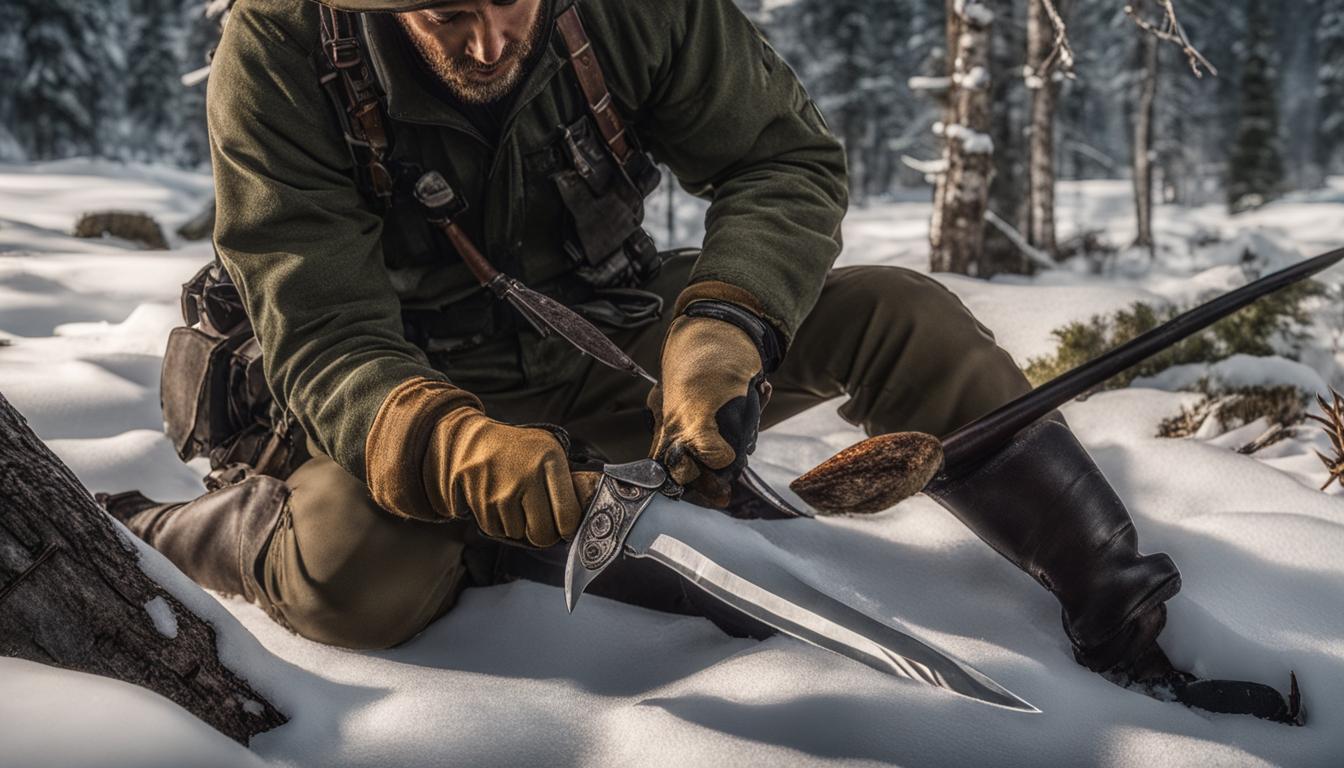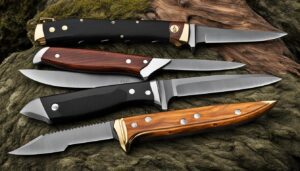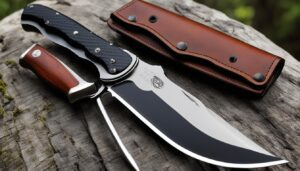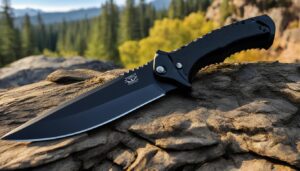In this comprehensive guide, I will explore the unmatched utility of the hunting knife with gut hook. From understanding the different blade types and materials to considering the handle design and tang type, I will provide all the information you need to elevate your hunting trips with this essential tool.
- A hunting knife with a gut hook is a versatile tool for hunters and outdoor enthusiasts.
- Consider the blade type, material, size, handle material, and tang type when choosing a hunting knife.
- Blade types like drop point, clip point, and gut hook offer different functionalities for various tasks.
- Factors such as intended use, blade length, handle comfort, weight and balance, and blade thickness should be considered when selecting a hunting knife.
- Choosing the right hunting knife will enhance your hunting experience and enable you to perform tasks effectively.
The Essential Features of a Hunting Knife
When it comes to choosing a hunting knife, there are several key features that you should consider. Each of these features contributes to the overall functionality and performance of the knife. So, let’s dive into the essential features that make a hunting knife a valuable tool for any hunting expedition.
Blade Type
The blade type is one of the most important aspects to consider when selecting a hunting knife. Different blade types offer different advantages and are suited for specific tasks. Common blade types for hunting knives include:
- Drop Point Blade: Known for its versatility and strength, the drop point blade is ideal for general-purpose tasks.
- Clip Point Blade: The clip point blade features a sharp, thin tip that excels at piercing and detail work.
- Gut Hook Blade: Specifically designed for field dressing game, the gut hook blade makes skinning and opening up animals easier.
Blade Material
The material used for the blade greatly affects its performance, durability, and maintenance. Some common blade materials for hunting knives include:
- Stainless Steel: Stainless steel blades are resistant to rust and corrosion, making them low maintenance and versatile.
- Carbon Steel: Known for its exceptional strength and edge retention, carbon steel blades require more maintenance to prevent rust.
- High-Carbon Stainless Steel: This type of blade material combines the corrosion resistance of stainless steel with the durability of carbon steel.
Blade Size, Handle Material, and Tang Type
Blade size, handle material, and tang type are additional factors to consider when choosing a hunting knife. Blade size should be determined based on your intended use and personal preferences. Handle material plays a crucial role in grip comfort and durability. Common handle materials include wood, synthetic materials like G10 or Micarta, and rubber. The tang type, which refers to the part of the blade that extends into the handle, affects the knife’s strength and durability.
By carefully considering these essential features, you can find a hunting knife that best suits your needs and enhances your overall hunting experience.
Exploring Different Blade Types and Their Uses
When it comes to hunting knives, the blade type is a crucial factor to consider. Each blade type has its own unique characteristics and applications that make it suitable for specific tasks and situations. Let’s explore some of the most common blade types and their uses:
Drop Point Blade
The drop point blade is one of the most popular blade types for hunting knives. It features a convex curve that creates a strong and versatile tip, making it ideal for precision work and general-purpose tasks. The robust tip also adds durability to the blade, allowing for effective piercing and controlled cutting.
Clip Point Blade
The clip point blade stands out with its concave curve and sharp, narrow point. This blade type is designed for tasks that require excellent piercing ability and control. It is often used for detailed work, such as skinning and caping, and is favored by hunters who need precision in their cutting tasks.
Gut Hook Blade
The gut hook blade is specifically designed for easy game opening and cleaning. It features a small, sharpened hook on the spine of the blade that allows hunters to make precise and controlled incisions without puncturing the internal organs. This blade type is essential for field dressing and gutting game.
Tanto Blade
The tanto blade is characterized by its angular tip and straight cutting edge. Originally designed for Japanese swords, this blade type offers exceptional piercing power. It is ideal for tasks that require deep penetration, making it a popular choice for hunters who need to pierce tough materials, such as thick hide or bone.
Spear Point Blade
The spear point blade features a symmetrically shaped blade with a point that aligns with the centerline. This blade type is designed for thrusting and cutting, making it versatile for various hunting tasks. The symmetric shape allows for balanced cutting and controlled thrusting, providing hunters with a dependable all-around blade.
Understanding the different blade types and their uses can help you choose the hunting knife that best suits your needs and preferences. Whether you prioritize versatility, precision, or specialized tasks, there is a blade type that will enhance your hunting experience.
Factors to Consider When Choosing a Hunting Knife
Choosing the right hunting knife is crucial for a successful hunting trip. There are several factors that you should take into consideration to ensure that you find the perfect knife for your needs. Let’s explore these factors in detail:
Intended Use
First and foremost, consider the intended use of the hunting knife. Are you primarily using it for field dressing game? Or do you plan on using it for camping and other outdoor activities as well? Knowing the primary purpose of your knife will help you determine the ideal features and specifications.
Blade Length
The blade length is another important factor to consider. The length of the blade should be chosen based on the specific tasks at hand and your personal preferences. A longer blade may be more suitable for tasks that require deep cuts, while a shorter blade offers better maneuverability in tight spaces.
Handle Comfort
A comfortable handle is essential for a secure grip and ease of use. Consider the material and design of the handle to ensure that it provides a comfortable and ergonomic grip. Handles made of materials like rubber or textured synthetic materials can offer better grip and control, even in wet conditions.
Weight and Balance
The weight and balance of the knife are important factors to consider for optimal performance. You want a knife that feels balanced in your hand and is not too heavy or too light. The right weight and balance will ensure that you have better control over the knife and can make accurate cuts with ease.
Blade Thickness
The thickness of the blade determines its durability and precision. Thicker blades are generally more durable and can withstand heavier use, while thinner blades offer better precision for intricate tasks. Consider the type of hunting you will be doing and choose a blade thickness accordingly.
By considering these factors when choosing a hunting knife, you can find the perfect tool that meets your needs and preferences. Remember to take into account the intended use, blade length, handle comfort, weight and balance, and blade thickness to ensure that you have a reliable and versatile companion for your hunting adventures.
Conclusion
The hunting knife with gut hook is truly an essential tool for any outdoor enthusiast. Its versatility in various tasks, such as field dressing game and preparing campfire meals, makes it a must-have for hunting trips. By understanding the different blade types, materials, and important factors to consider when choosing a hunting knife, you can find the perfect tool that meets your needs and preferences.
The diverse range of hunting knife options available allows you to embrace the versatility and unlock new possibilities in your hunting adventures. Whether you’re looking for a drop point blade for precision work, a gut hook blade for easy game opening, or a tanto blade for exceptional piercing power, there is a blade type suited for every task.
When selecting a hunting knife, consider factors such as the intended use, blade length, handle comfort, weight and balance, and blade thickness. These considerations are key in ensuring that you choose a knife that not only performs well but also feels comfortable in your hand. With the right hunting knife by your side, you can elevate your outdoor experience and make the most out of your hunting trips.
In conclusion, the hunting knife with gut hook is more than just a tool. It is an invaluable companion that enhances your hunting endeavors and helps you tackle various tasks in the wilderness. So, embrace the versatility, consider the blade types, and keep these important factors in mind – the perfect hunting knife awaits you.
FAQ
What are the different blade types for hunting knives?
The common blade types for hunting knives include the drop point blade, clip point blade, gut hook blade, tanto blade, and spear point blade.
What materials are commonly used for hunting knife blades?
Stainless steel, carbon steel, and high-carbon stainless steel are commonly used materials for hunting knife blades.
How should I choose the size of the blade?
The size of the blade should be chosen based on the specific tasks and personal preferences.
What factors should I consider when choosing a hunting knife?
Factors to consider when choosing a hunting knife include the intended use, blade length, handle comfort, weight and balance, and blade thickness.
What is the gut hook blade specialized for?
The gut hook blade is specialized for easy game opening and cleaning.





